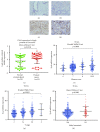Eya2 Is Overexpressed in Human Prostate Cancer and Regulates Docetaxel Sensitivity and Mitochondrial Membrane Potential through AKT/Bcl-2 Signaling
- PMID: 31317026
- PMCID: PMC6601494
- DOI: 10.1155/2019/3808432
Eya2 Is Overexpressed in Human Prostate Cancer and Regulates Docetaxel Sensitivity and Mitochondrial Membrane Potential through AKT/Bcl-2 Signaling
Abstract
The aberrant expression of Eya2 has been observed in a wide range of cancer types. However, the clinical significance and biological effects of EYA2 in human prostate cancer remain unknown. In this study, we showed that increased levels of Eya2 protein correlated with advanced TNM stage, T stage, and a higher Gleason score. Data from the Cancer Genome Atlas (TCGA) prostate cohort consistently revealed that Eya2 mRNA was positively correlated with a higher Gleason score, higher T stage, and positive nodal metastasis in prostate cancer. Furthermore, data from the Oncomine database showed increased levels of EYA2 mRNA expression in prostate cancer tissues compared with normal tissues. Eya2 protein expression was also higher in prostate cancer cell lines compared with a normal RWPE-1 cell line. We selected LNCaP and PC-3 cell lines for plasmid overexpression and shRNA knockdown. CCK-8, colony formation, and Matrigel invasion assays demonstrated that the overexpression of Eya2 promoted proliferation, colony number, and invasion while Eya2 shRNA inhibited proliferation rate, colony formation, and invasion ability. CCK-8 and Annexin V assays showed that Eya2 reduced sensitivity to docetaxel and docetaxel-induced apoptosis while Eya2 shRNA showed the opposite effects. The overexpression of Eya2 also downregulated the cleavage of caspase3 and PARP while Eya2 depletion upregulated caspase3 and PARP cleavage. Notably, JC-1 staining demonstrated that Eya2 upregulated mitochondrial membrane potential. We further revealed that the overexpression of Eya2 upregulated Bcl-2, matrix metalloproteinase 7 (MMP7), and AKT phosphorylation. Accordingly, data from the TCGA prostate cohort indicated that EYA2 mRNA was positively correlated with the expression of Bcl-2 and MMP7. The inhibition of AKT attenuated EYA2-induced Bcl-2 upregulation. In conclusion, our data demonstrated that Eya2 was upregulated in prostate cancers. EYA2 promotes cell proliferation and invasion as well as cancer progression by regulating docetaxel sensitivity and mitochondrial membrane potential, possibly via the AKT/Bcl-2 axis.
Figures





References
MeSH terms
Substances
LinkOut - more resources
Full Text Sources
Medical

